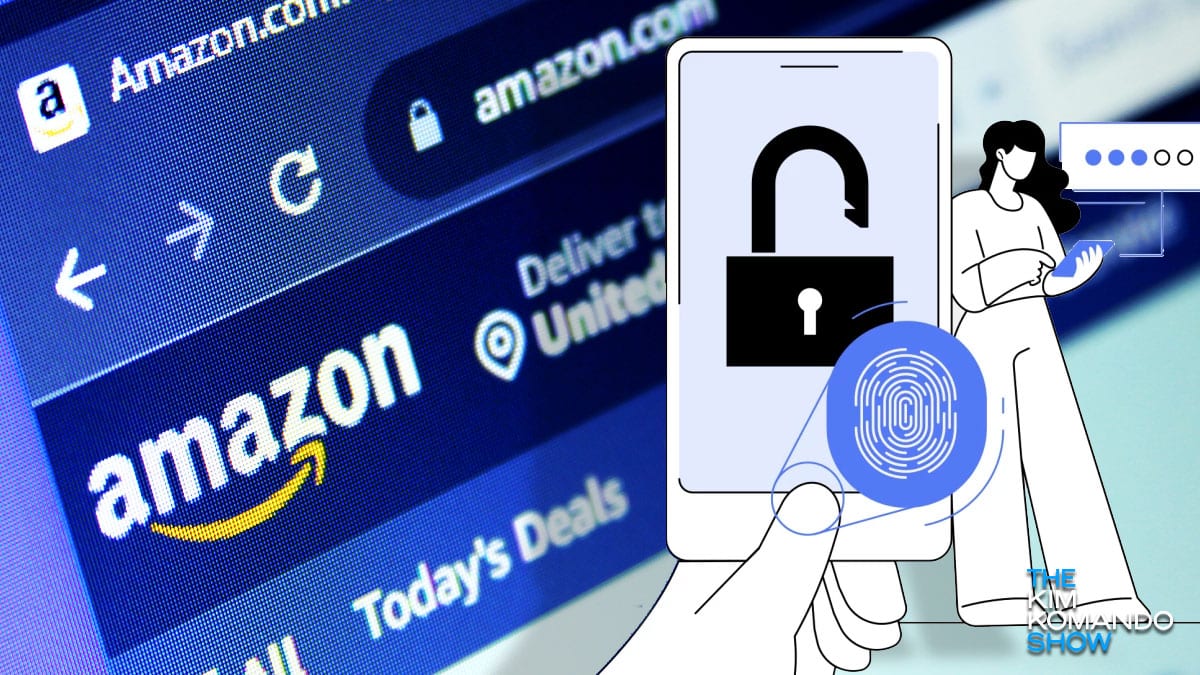The Current Plus: 66% of Americans say AI can do their job, mortgage loan hack, DIY iPhone repair  In partnership with TotalAV | | Hello on this bright and cold Tuesday, friends! Let’s kick off things with a little tech know-how. Which of the following will totally destroy your Wi-Fi signal strength? Is it … A.) LED lights, B.) Wooden furniture, C.) Mirrors or D.) Ceramic tiles? You’ll find the answer at the end. 🤓 You’re reading this because you’re tech-smart — or want to be. Cybersecurity 101: Don’t go it alone. You need good antivirus protection to catch what you can’t. My pick is TotalAV — just $19 for the first year on up to five devices. You won’t find a better deal anywhere, I promise. Your support of our sponsors keeps this newsletter free, so thanks! — Kim 📫 First-time reader? Sign up here. (It’s free!) IN THIS ISSUE - 🔑 Keys to the (Amazon) castle
- ⚠️ Data hog exposed: Comcast
- 🚨 Hackers hit mortgage company
|
TODAY'S TOP STORY A quick guide to Amazon passkeys  Whenever something new that can help protect your security pops up, you can count on me to make sure you know about it. Good news: Amazon just got on board the passkey train. Passkeys replace your probably-not-that-strong password with something no one can hack: Your fingerprint or face ID. A weak password brings all the hackers to the yard — and your Amazon cart, too — so this is a welcome addition to our cybersecurity arsenal. I’m not gonna lie; there are a few steps involved to get ‘er done, so just follow the guide below, and you’ll be up and running in no time. (Pass)keys to the kingdom The beauty of passkeys? They're easier to use (no remembering your password!) and super secure. A passkey lets you sign into your favorite apps and websites using a PIN, fingerprint or facial recognition. One passkey is actually made up of two elements — a public key that's registered with the account you have through a website or app and a separate key stored privately on the device you use to log in. It never leaves your device, so it’s inherently safer than one a company stores on its servers. When these powers are combined, you get a more hacker-proof sign-in process. Smell ya later, crooks. Now repeat after me You can do this from your computer or phone. Your call! On the web - Go to Amazon.com, log into your account, hover over the Accounts & Lists button, then go to Account > Login & security.
- Enter your password once more. (Note: You'll also be sent a verification code to enter.)
- Next to Passkey, click the Setup button. Click Setup again.
- If you already use a password manager, Amazon may ask if you want to store your passkey there.
From there, options will pop up based on the device you’re using and the others associated with your account. That might include your fingerprint, face, phone, or Google or Apple profile. FYI, if your computer prompts you to use a physical security key, ignore it — unless you have one, in which case good for you! Through the app Note: Your phone needs to be updated to at least iOS 16 or Android 9. - Sign into the app using your Amazon account credentials.
- Tap the profile icon on the bottom toolbar.
- Tap Your Account and Login & security under Account settings. If prompted, sign into your Amazon account again. (Note: You'll also be sent a verification code to enter.)
- From the “Login & security” page, click the Setup button next to Passkey. Click Setup again on the following page.
Android users: A pop-up will ask if you want to create a passkey for Amazon Shopping. Click Continue, follow the steps onscreen, and you’ll be all set. iPhone users: You’ll get a prompt asking if you want to use Face ID or Touch ID to sign in. Pick your favorite, then Continue. That’s it! 😆 I ordered a deck of cards from Amazon. Two weeks later, it still hasn't arrived. Customer service told me they're dealing with it. |
| IN PARTNERSHIP WITH |  |
It’s not just about stopping malware and viruses Hackers are smarter than ever, and their tricks can work on even the most tech-savvy folks. I know because I talk to people who get fooled every single week. Whether you're surfing on your laptop, checking emails on your tablet or shopping on your phone, TotalAV will keep you safe. - Instantly identify and block misleading websites. TotalAV's advanced Webshield functionality is your shield against phishing attempts.
- Detect, block and eliminate harmful malware threats and viruses in real time.
- TotalAV's System Tune-Up feature removes unwanted applications, clears redundant files and optimizes caching to keep your system running at its best.
You get all that across up to five devices (Windows, Mac, Android and iOS) with my exclusive offer: Just $19 for the first year. You can’t beat that. Protect yourself now before it’s too late. → |
WEB WATERCOOLER ⚠️ The tracking never ends: Comcast Xfinity is storing your sensitive data, and there’s not a whole lot you can do about it. Customers are automatically opted-in, and they collect details like political beliefs and sexual orientation. To “partially opt-out,” go to Xfinity's Privacy Center. FYI, opting out only cuts down on personalized ads and marketing. Unbelievable we have to deal with this crap. Hackers hit another loan and mortgage company: A ransomware attack on LoanDepot exposed the personal info of 16.6 million customers. There aren’t many details yet, but they've promised to alert everyone impacted. LoanDepot’s online services are a mess post-attack, and folks can't access their accounts or make payments. Maybe a place called LoanDepot wasn't the safest bet. Just saying. 💸 Grabbing every penny: Apple is slapping new fees on app transactions, even after being told to ease up on its 30% “Apple tax.” Now, there’s a 27% commission on payments for anything. Apps like Audible are hiking prices to make up for it. Yeah, you and I are paying extra, not Apple. Even more not-so-fine print: Prompted by a $5 billion lawsuit, Google wants you to know its Chrome browser’s Incognito mode isn't so private after all. The new disclaimer? "Others won't see your activity, but websites, including Google, will." While Incognito mode hides your browsing from others on your device, it doesn't stop Google and websites from tracking you. You can always try Safari's Private Browsing or a privacy-first browser like DuckDuckGo. 🤖 Embrace AI or be replaced: A recent Spokeo survey says two of every three Americans think AI could do their jobs. Yep, 66.6% are worried. Weird number, right? But hey, 78.1% also think AI means less stress and shorter workweeks (fingers crossed). Learn to love your robot overlords, folks. “I can't believe he's gone:” A new Facebook scam is making the rounds, and it’s all about a loved one who died. Their emotional post links to a BBC article — wait, nope, it links to a malware download. Don’t click scammy links. That’s one smart way to keep out this junk. iPhone or Mac acting up? Skip the Apple Store and try the new built-in diagnostic tool. FYI, it's designed for those with the knowledge to repair their devices, so it's not for everyone. Right now, it works with iOS 17 and macOS Sonoma 14.1 and later. Just pop your iPhone or Mac into diagnostics mode, enter the serial number, and let the troubleshooting begin. Fun times. Fool me once: A Massachusetts woman was swindled out of $150,000 in a romance scam. But wait, there's more — she was targeted by scammers posing as CIA agents accusing her of backing terrorism. She told the fake agents to meet her at the police station. They never showed. Now, she's taking on her bank for not catching those giant transfers. I'm rooting for her. |
DEVICE ADVICE Quick privacy upgrade Apple keeps track of where you go and how often you go there. You might see these so-called “Significant Locations” as calendar events or map direction alerts. Yeah, you can clear this list. - On your iPhone, go to Settings > Privacy & Security > Location Services > System Services.
- Tap Significant Locations.
- Hit the Clear History button.
You know Google is snoopy, too. It might save where you go even when you aren’t using Google Maps. Switching off “Location History” stops this tracking. - Sign in to your Google account. Tap your profile picture, then Manage your Google Account, or go to your Google Account page.
- On the left, click Data & privacy.
- Under History settings, tap Location History.
- You can toggle this Off.
To delete your location history data, click on the Auto-delete option. I chose three months and recommend you do the same. |
LISTEN UP  | Is your tech reporting back to China? You have a lot of smart devices. I have an easy way to check which countries they're connected to. Plus, I answer one of your burning tech questions! |
|---|
|
TECH LIFE UPGRADES Don’t miss it! Every weekday, I stream my podcast, Kim Komando Today, live, and you can tune in. Catch me, Andrew, Allie and the interesting folks we have lined up at 11:30 a.m Arizona time. Watch on YouTube or Facebook (for now, but more coming soon!). Watch yesterday’s episode here if you missed it. 📖 Free audiobooks: LibriVox offers thousands of free audiobooks, primarily public-domain books. Volunteers make the recordings, which you can listen to on the website or download to your device. Pass me a cold one: Relay hacks and keyless jamming are ways someone can take over your car’s key fob. Paid solution: Buy a signal-blocking case, like this shielded RFID-blocking pouch. Free solution: Store your key fob in the refrigerator or freezer; the multiple layers of metal block the signal. 📺 Freebies from Roku: Look for over 40 new channels on your Roku, including local news from New York, Los Angeles, Miami and other major cities. Free to watch, but there are ads. Fair enough. Alone Musk: iPhone owners got this last October. Now, Android can make audio and video calls through X. While anyone can receive calls, only those paying for Premium at $8 a month can make them. Switch it off if you want. On the phone app, hit the messages icon at the bottom (an envelope), then the settings cog in the top corner. Switch off “Enable audio and video calling.” Elon, I assure you we’re all fine without this. |
DEALS OF THE DAY You got to move it, move it OK, all the holiday cobwebs are off at this point. Ready to buckle down on your resolution to get in shape? |
BY THE NUMBERS 175,000,000 Attempts police have to open a suspect’s phone. A Canadian judge ruled police must return or destroy three phones seized from a suspected pedophile after that many failed tries. How many potential codes are there? Approximately 44 nonillion. That’s 44,012,666,865,176,569,775,543,212,890,625. 1,000,000,000 Humanoid robots Elon Musk predicts will be on Earth in two decades. Bet he’s hoping so for a few reasons, but mostly because the Tesla Bot will cost an estimated $20,000. $200 Cost for Applebee’s new subscription date night pass. Pay once and get $30 in food and nonalcoholic drinks each time you go through Jan. 31, 2025. Bad but funny idea: Buying this to take out all your online dates. Boneless wings, anyone? |
WHAT THE TECH?  Love at frostbite.
|
UNTIL NEXT TIME ... The answer: C.) Mirrors. They can kill a Wi‑Fi signal, and not because you’re so incredibly good-looking. The thin coat of metal on the glass of a mirror causes electromagnetic interference, so you don’t want to place a router near one. The other day, I was driving, and my son, Ian, was in the passenger seat. I put the car in reverse, looked in the rearview mirror and said, “Ah, that takes me back!” He groaned. 🛑 Folks, I wouldn’t tell you about antivirus software if it didn’t matter. Use this link for a great deal on TotalAV ($19 for a year, up to 5 devices) — the best you’ll find out there. Stay warm today, and I’ll see you back here tomorrow with the best tech newsletter in the USA! — Kim |
Komando Referral Program Share this newsletter → Earn prizes! Step 1: Copy your unique referral link: https://www.komando.com/friends/?referralCode=0rvmdp6 Step 2: Share your link! Post it on social media, send it in a text or paste it into an email to a pal. If they sign up using that link, you get the credit!  |
How'd we do? What did you think of today's issue? |
|
|
